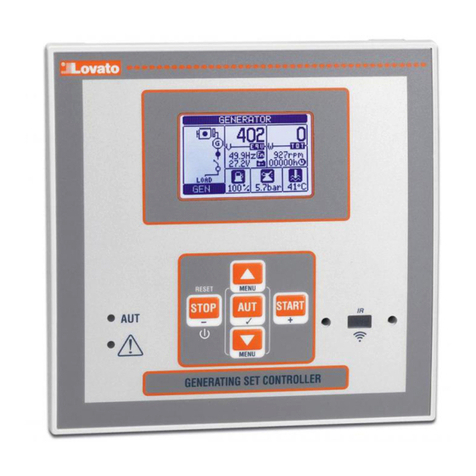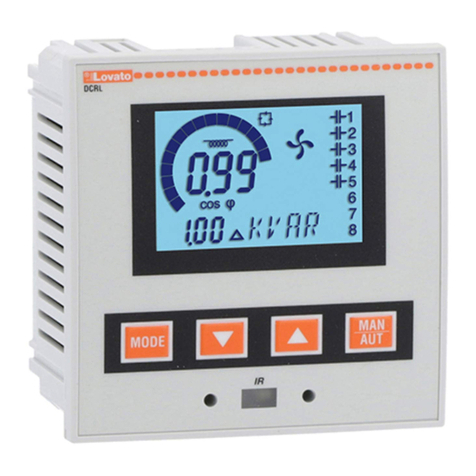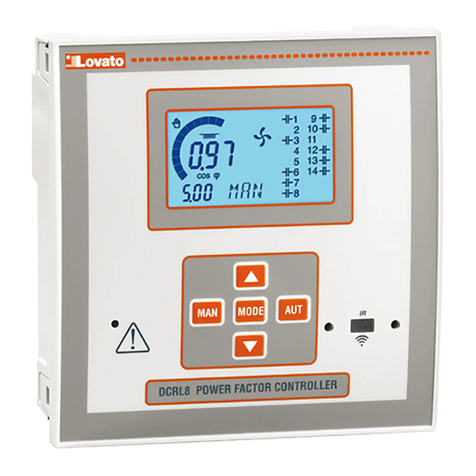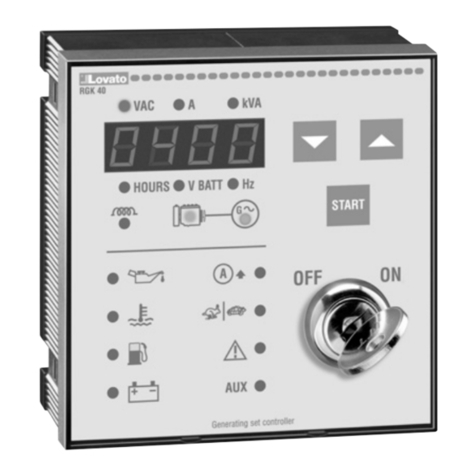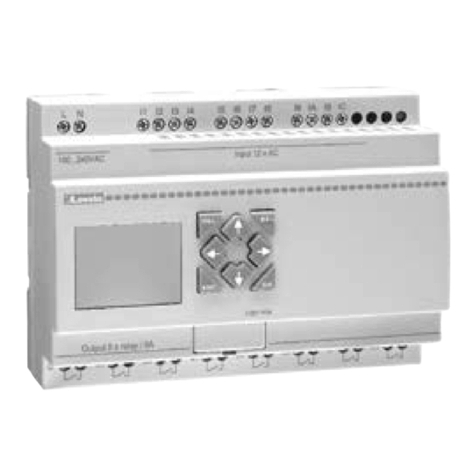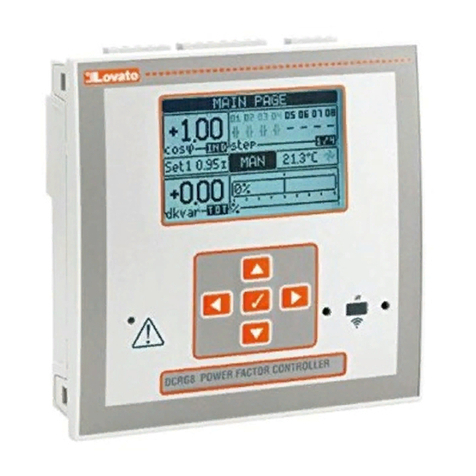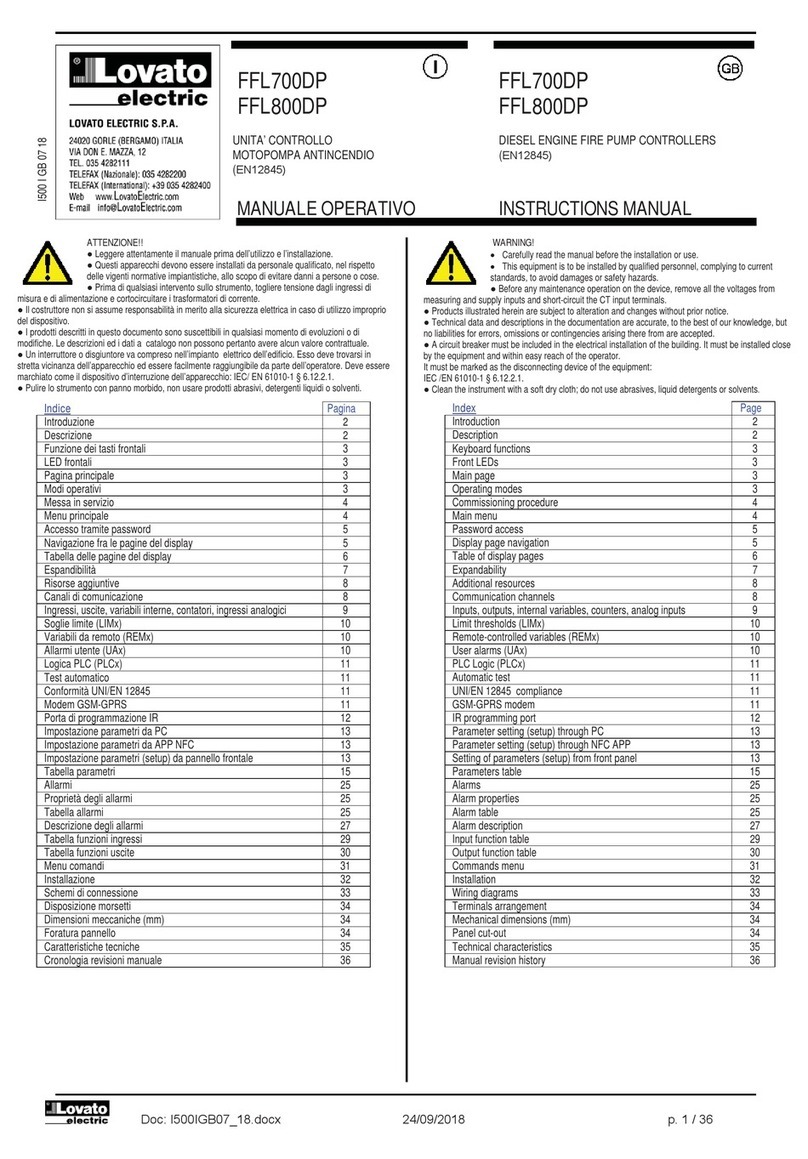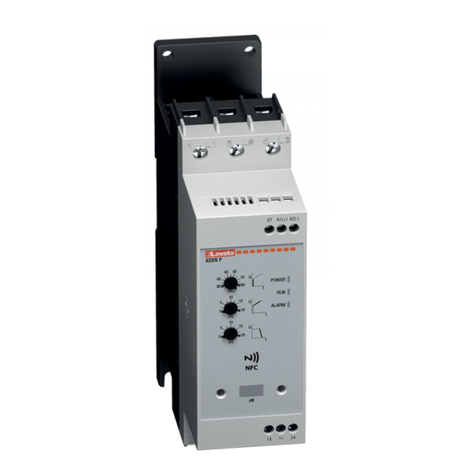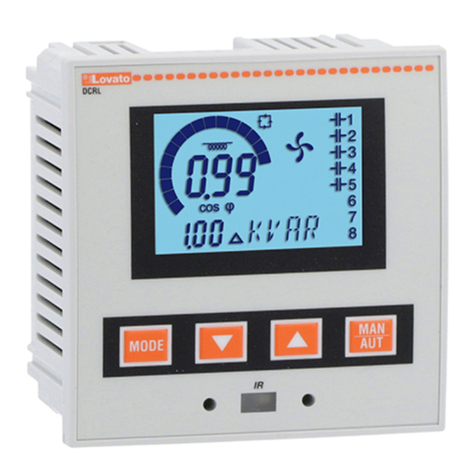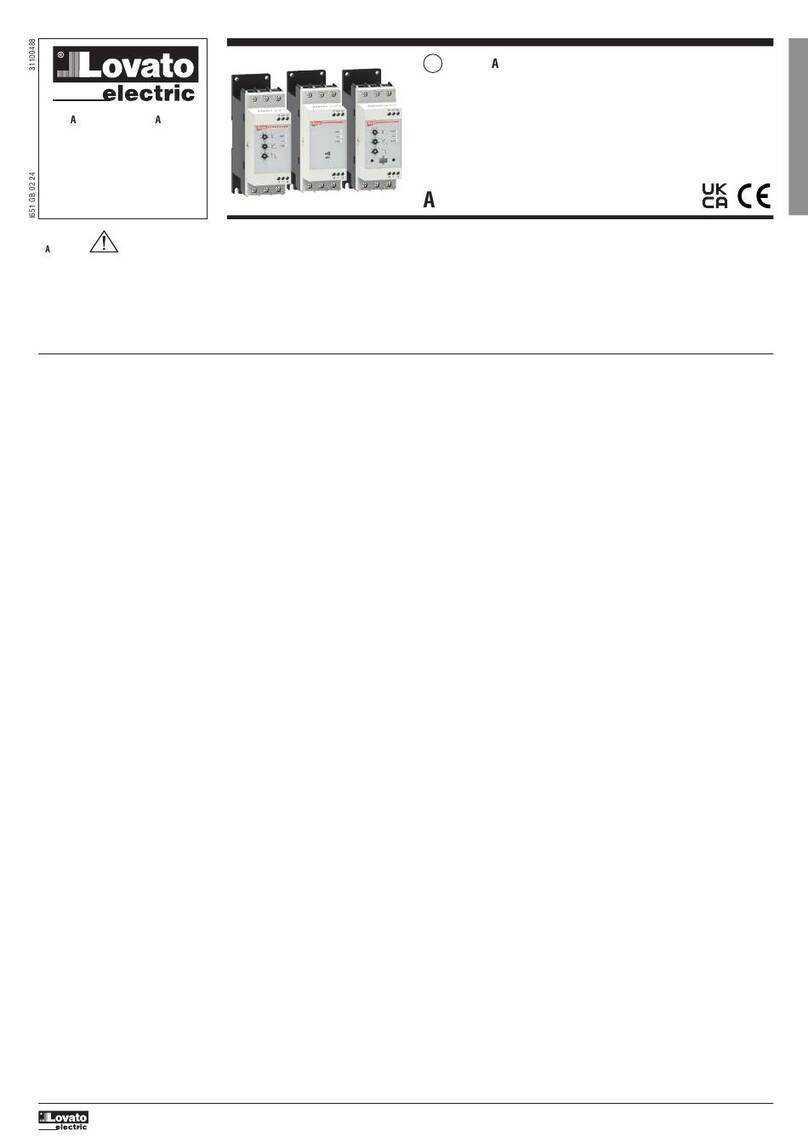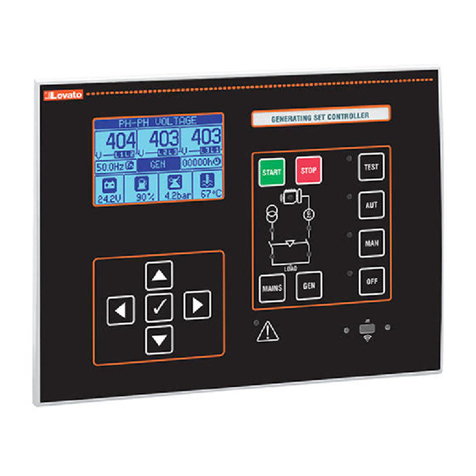
I431 GB I 02 16 31100245
8
P02.01 – The value of the primary current transformer. Example: with CT 800/5A set 800.
If set to OFF, after the power-up the device will prompt you to set the CT and allow direct
access to this parameter.
P02.02 – Value of the secondary of the current transformers. Example: With CT 800/5A, set 5.
P02.04 – Defines on which and on how many phases the device reads the current signal. The wiring of
current inputs must match the value set for this parameter. Supports all possible
combinations of parameter P02.06.
P02.05 – Reading the connection polarity of the CTs.
Aut = Polarity is automatically detected at power up. It can be used when working with one CT
only and when the system has no generator device.
Dir = Automatic detection disabled. Direct connection.
Rev = Automatic detection disabled. Reverse wiring.
P02.06 – Defines on which and on how many phases the device reads the voltage signal.
The wiring of voltage inputs must match the setting for this parameter. Supports all possible
combinations of parameter P02.04.
P02.07 – Value in kvar of the smallest step installed (equivalent to the step weight 1). Rated power of
the capacitor bank provided at the rated voltage specified in P02.08 and referred to the total of
the three capacitors for three-phase applications.
P02.08 – Rated nameplate voltage of capacitors, at which the specified power of P02.07 is supplied. If
the capacitors are used at a voltage different (lower) than rated one, the resulting power is
automatically recalculated by the device.
P02.09 – Working frequency of the system. Auto = Automatic selection between 50 and 60 Hz at power
up. 50Hz = Fixed at 50 Hz. 60Hz = Fixed to 60 Hz.
Variable = Measured continuously and adjusted.
P02.10 – Minimum time that must elapse between the disconnection of one step and the subsequent
reconnection both in MAN and AUT. During this time, the number of the steps on the main
page is shown in light grey.
P02.11 – Connection sensitivity. This parameter sets the reaction speed of the controller.
With low values, adjustment is fast (more accurate around the setpoint but with more step
switchings). Instead, with high values, there are slower adjustment reactions with fewer
switchings of the steps.
The delay time of the reaction is inversely proportional to the request of steps to reach the
setpoint: waiting time = (sensitivity / number of steps required).
Example: Setting the sensitivity to 60s, for the connection of one step of weight 1, waiting time
is 60s (60/1 = 60). If instead, a total of 4 steps is needed, waiting time is 15s (60/4 = 15).
P02.12 – Disconnection sensitivity. Same as the previous parameter but related to disconnection. If set
to OFF, the disconnection has the same reaction time as connection set with the previous
parameter.
P02.13 – Setpoint (target value) of the power factor (cosphi). Value used for standard applications.
P02.14 – P02.15 – Alternative setpoints selectable with combinations of digital inputs programmed with
the appropriate function.
P02.16 – Setpoint used when the system is generating active power to the provider (with both active
power / cosphi negative).
P02.17 – P02.18 – Tolerance for the setpoint. When the cosphi is within the range delimited by these
parameters, in AUT mode, the device does not connect / disconnect steps even if the delta-kvar
is greater than the smallest step.
Note: + means “tends to inductive”, - means “tends to capacitive”.
P02.19 – If set to ON, when the system is giving active power to the supplier (generation = negative
active power and power factor), all steps are disconnected.
P02.20 – Rated current of the system. Value used for the full scale of the bar graphs and for setting the
current thresholds, expressed as a percentage.
If set to Aut, then the value of P02.01 (CT primary) is used.
P02.21 – Rated voltage of the system. Value used for the full scale of the bar graphs and setting the
voltage thresholds, expressed as a percentage.
If set to Aut, then the value of P02.08 (rated voltage of capacitors) is used.
P02.22 – Type of system voltage. Depending on the setting of this parameter, the appropriate wiring
diagrams must be used. See at the end of the manual.
P02.23 ... P02.27 – Data of VTs eventually used in the wiring diagrams.
P02.28 – Selection of step connection mode
Standard = Normal operation with free selection of the steps.
Linear = The steps are connected in progression from left towards right only, following the
step number and according to LIFO (Last In First Out) logic. When the system steps are of
different ratings, the controller will not connect a step if the set-point value would be exceeded.
Fast = Fast switching for use with static/thyristor modules and parameter P03.n.02 set to
Static.
Single linear – Linear mode for which only one step is connected at each sensitivity trigger
regardless of the total number of steps required.
OFFON – As standard mode but at each sensitivity trigger, all the steps to disconnect are
switched off and then all the required steps to connect are switched on.
P02.29 – After having closed one step output, the measurement acquisition is suspended for the number
of periods (cycles) specified by this parameter, in order to allow the external static module to
connect the capacitors. This function avoids regulation oscillations. Set this value according to
the technical characteristics (closing time) declared by the manufacturer of the static module.
P02.30 – Enables the setting of the setpoint as Tangent of displacement phase angle (Tanphi) instead of
Cosine (Cosphi). Used as a reference by the energy providers of some European countries.
P02.31 – Value of the Tanphi setpoint. Negative Tanphi values correspond to capacitive Cosphi.
P02.32 – Sensitivity mode:
Proportional = The sensitivity time delay is inversely proportional to reactive power required.
Fixed = The sensitivity time delay is fixed, independent of reactive power required
P02.33 – Tanphi setpoint used when the system is generating active power to the provider (with active
power and cosphi both negative).
P02.34 – Angular offset for compensation of the phase shift introduced by a transformer between the
voltages on the primary and on the secondary ones.
P02.35 – Defines whether in a plant in which the compensation is carried out with both capacitors with
inductors, is permitted simultaneous connection of both types of steps or less. MIX = It is
possible to have a mixed combination of capacitors and inductors. NON-MIX = capacitors or
inductances are never connected together, depending on the nature of the load.
P02.01 – Valore del primario dei trasformatori di corrente. Esempio: con TA 800/5A impostare 800. Se
impostato su OFF, alla messa in tensione l’apparecchio richieerà di impostare il TA e permetterà
l’accesso diretto a questo parametro.
P02.02 – Valore del secondario dei trasformatori di corrente. Esempio: con TA 800/5A impostare 5.
P02.04 – Definisce su quali e su quante fasi l’apparecchio legge il segnale di corrente. Il collegamento
degli ingressi amperometrici deve coincidere con quanto impostato in questo parametro. Sono
supportate tutte le combinazioni possibili con il parametro P02.06.
P02.05 – Lettura della polarità di collegamento dei TA.
Aut = La polarità è riconosciuta automaticamente alla messa in tensione. Utilizzabile solo
quando si lavora con un solo TA e quando l’impianto non ha alcun dispositivo generatore.
Dir = Riconoscimento automatico disabilitato. Collegamento diretto.
Inv = Riconoscimento automatico disabilitato. Collegamento inverso.
P02.06 – Definisce su quali e su quante fasi l’apparecchio legge il segnale di tensione. Il collegamento
degli ingressi voltmetrici deve coincidere con quanto impostato in questo parametro. Sono
supportate tutte le combinazioni possibili con il parametro P02.04.
P02.07 – Valore in kvar dello step più piccolo installato (equivalente al peso 1). Potenza di targa del
banco di condensatori erogato alla tensione di targa specificata in P02.08 e riferito al totale dei
tre condensatori se in applicazione trifase.
P02.08 – Tensione nominale di targa dei condensatori, alla quale viene erogata la potenza specificata in
P02.07. Se i condensatori sono utilizzati ad un tensione diversa (inferiore) rispetto a quella
nominale, la potenza risultante viene ricalcolata automaticamente dall’apparecchio.
P02.09 – Frequenza di lavoro dell’impianto. Aut = selezione automatica fra 50 e 60 Hz alla messa in
tensione. 50Hz = fissa a 50 Hz. 60Hz = fissa a 60 Hz.
Variabile = misurata continuamente ed adattata.
P02.10 – Tempo minimo che deve trascorrere fra la disconnessione di uno step e la successiva
riconnessione sia in MAN che in AUT. Durante questo tempo il numero dello step sulla pagina
principale è indicato in grigio chiaro.
P02.11 – Sensibilità alla connessione. Parametro che imposta la velocità di reazione del regolatore. Con
valori bassi la regolazione è veloce (maggior precisione intorno al setpoint ma maggior numero
di manovre). Con valori alti invece si hanno reazioni più lente della regolazione, con minor
numero di manovre degli step.
Il tempo di ritardo alla reazione è inversamente proporzionale alla richiesta di step per
raggiungere il setpoint: tempo attesa = (sensibilità / numero di step richiesti).
Esempio: impostando la sensibilità a 60s, se viene richiesta l’inserzione di uno step di peso 1
vengono attesi 60s (60/1 = 60) . Se invece servono un totale di 4 step verranno attesi 15s
(60 / 4 = 15).
P02.12 – Sensibilità alla disconnessione. Come parametro precedente ma riferita alla disconnessione.
Se impostata ad OFF la disconnessione ha gli stessi tempi di reazione della connessione
regolata con il parametro precedente.
P02.13 – Setpoint (valore da raggiungere) del cosfi. Valore utilizato in applicazioni standard.
P02.14 –P02.15 – Setpoint alternativi, selezionabili via combinazioni di ingressi digitali programmati
con l’apposita funzione.
P02.16 – Setpoint utilizzato quando l’impianto sta generando potenza attiva verso il fornitore (con
potenza attiva/ cosfi di segno negativo).
P02.17 –P02.18 – Tolleranza intorno al setpoint. Quando il cosfi si trova all’interno della fascia
delimitata da questi parametri, in AUT non vengono inseriti/disinseriti dei step anche se il
delta-kvar è maggiore dello step più piccolo.
Nota: + significa “verso induttivo”, - significa “verso capacitivo”.
P02.19 – Se impostato ad ON, quando il sistema sta cedendo potenza attiva al fornitore (generazione =
potenza attiva e cosfi negativi) tutti gli step vengono scollegati.
P02.20 – Corrente nominale dell’impianto. Valore utilizzato per il fondoscala delle barre grafiche e per
l’impostazione delle soglie di corrente espresse in percentuale. Se impostato su Aut viene
utilizzato il valore di P02.01 (primario TA).
P02.21 – Tensione nominale dell’impianto. Valore utilizzato per il fondoscala delle barre grafiche e per
l’impostazione delle soglie di tensione espresse in percentuale. Se impostato su Aut viene
utilizzato il valore di P02.08 (tensione nominale condensatori).
P02.22 – Tipologia tensione impianto. A seconda della impostazione di questo parametro devono essere
utilizzati gli schemi di collegamento opportuni, riportati in fondo al manuale.
P02.23…P02.27 – Dati dei TV eventualmente utilizzati negli schemi di collegamento.
P02.28 – Selezione modalità inserzione step.
Standard - Funzionamento normale con selezione libera degli step
Lineare - I gradini vengono inseriti solo in progressione da sinistra verso destra seguendo il
numero di step, per poi essere disconnessi in modo inverso, secondo una logica LIFO (Last In,
First Out). In caso di gradini di potenza diversa, se l’inserzione di un ulteriore gradino
comporta il superamento del setpoint, il regolatore non lo inserisce.
Fast - Commutazione rapida; l’utilizzo con moduli a SCR e parametro P03.n.02 impostato a
statico.
Lineare singolo – Modalità lineare in cui viene inserito un solo gradino ad ogni innesco della
sensibilità indipendentemente dal numero di gradini totali necessari.
OFFON – Come da modalità standard ma ad ogni innesco della sensibilità prima vengono
disinseriti tutti i gradini da sconnettere e poi inseriti tutti i gradini da connettere.
P02.29 – Dopo aver comandato l’inserzione di uno step, la lettura delle misure viene sospesa per il
numero di periodi (cicli) specificato in questo parametro, in modo da permettere al modulo
statico di inserire i condensatori. Questa funzione permette di evitare l’innescarsi di oscillazioni
di regolazione. Regolare il tempo in base alle caratteristiche tecniche (tempo di chiusura)
dichiarate dal costruttore del modulo statico.
P02.30 – Abilita l’impostazione del setpoint come tangente dell’angolo di sfasamento (Tanfi) invece che
come coseno (Cosfi). Utilizzato come riferimento dall’ente fornitore di energia in alcuni paesi
europei.
P02.31 – Valore del setpoint Tanfi. Valori negativi di Tanfi corrispondono a cosfi capacitivi.
P02.32 – Selezione della modalità di sensibilità:
Proporzionale = Il tempo di ritardo della sensibilità è inversamente proporzionale alla potenza
reattiva richiesta.
Fissa = Il tempo di ritardo della sensibilità è fissa, indipendentemente dalla potenza reattiva
richiesta.
P02.33 – Setpoint Tanfi utilizzato quando il’impianto sta cedendo potenza attiva al fornitore (con potenza
attiva e cosfì negativi).
P02.34 – Offset angolare per compensazione dello sfasamento introdotto da un trasformatore tra le
tensioni sul primario e quelle sul secondario.
P02.35 – Definisce se in un impianto in cui la compensazione viene effettuata sia con condensatori che
con induttori, è ammessa la connessione contemporanea di entrambi i tipi di gradini o meno.
MIX = E’ possibile una combinazione mista di condensatori ed induttanze. NON-MIX =
Vengono connessi o solo condensatori o solo induttanze, a seconda della natura del carico.

